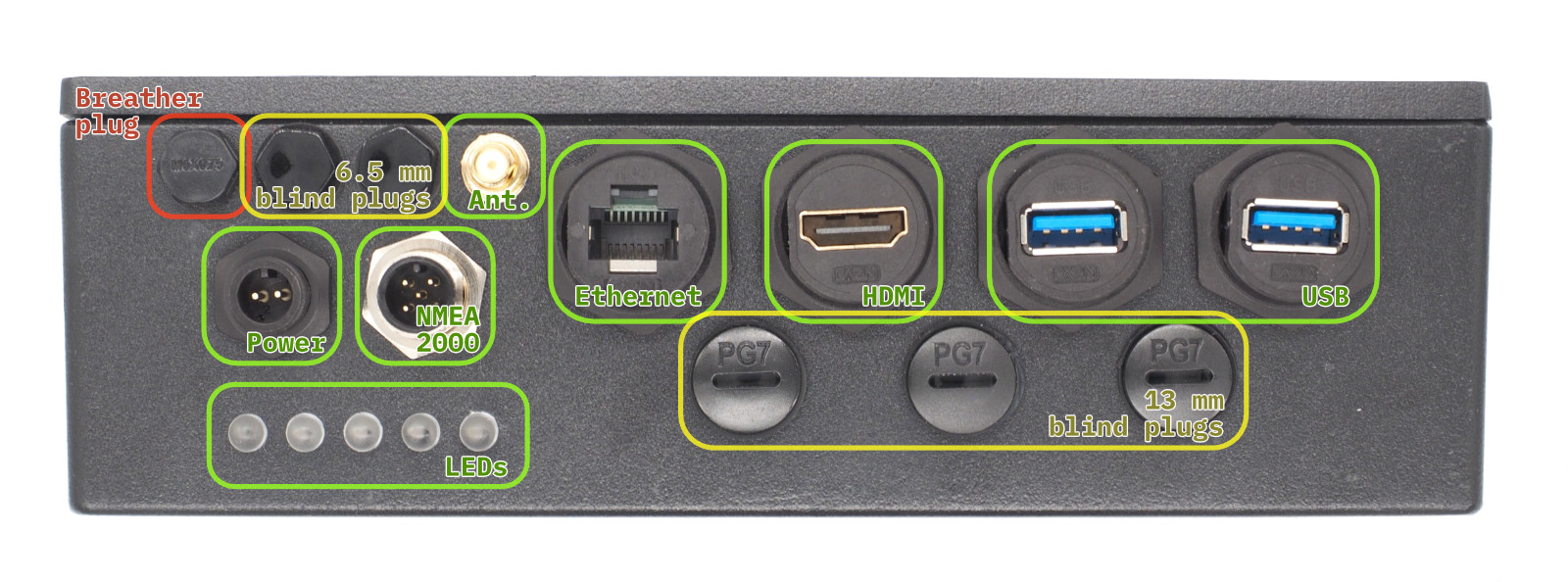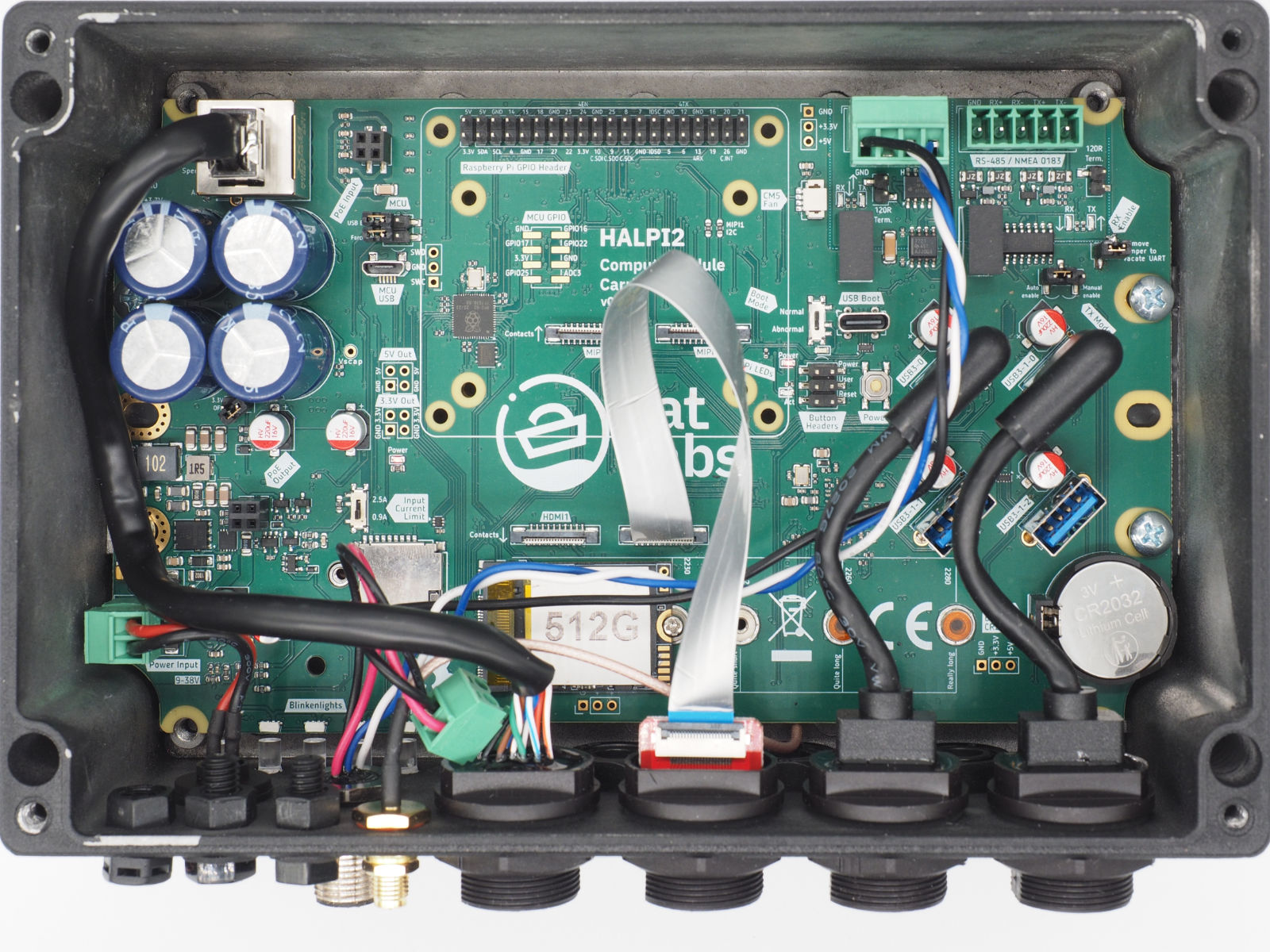Introduction
HALPI2 is a ready-to-use boat computer based on the Raspberry Pi Compute Module 5 (CM5). It offers a comprehensive set of features well suited for marine, automotive, and many industrial applications.

🔗 Shop Link
Purchase HALPI2 from the Hatlabs web shop.
What is HALPI2?
HALPI2 represents the latest evolution in rugged embedded computing, combining the power and ecosystem of Raspberry Pi with specialized features for demanding environments. Unlike standard single-board computers, HALPI2 is engineered from the ground up for 24/7 operation in harsh conditions where reliability is paramount.
The system integrates a Raspberry Pi Compute Module 5 with a custom carrier board, all housed in a waterproof aluminum enclosure that doubles as a heat sink. This design provides the computational power needed for modern applications while maintaining the robustness required for marine and industrial use.
Key Features and Capabilities
Enclosure Features
- Waterproof (IP65) aluminum enclosure, size 200×130×60 mm
- Standard connectors for power, NMEA 2000, gigabit ethernet, HDMI, 2× USB 3.0, and WiFi/Bluetooth antenna
- Flexible connectivity with options for 3× PG7 cable glands or SP13 waterproof connectors
- External antenna support via cutouts for 2 extra SMA connectors
- Wall-mount design with connectors positioned for easy installation

Hardware Features
- Wide input voltage range from 10 to 32 VDC with protection up to 100 VDC
- Intelligent current limiting: max input current 0.9 or 2.5 A, user-selectable
- Dual power options: 12V/24V direct connection or 12V NMEA 2000 bus power
- Super-capacitor backup for glitch immunity and graceful shutdown during power loss
- Advanced power management with automatic power loss detection
- Passive cooling design with CM5 in direct contact with enclosure
- High-speed storage via standard M.2 NVMe SSD interface
- Expansion capability through standard Raspberry Pi 40-pin GPIO header
- Rich I/O options: 2× HDMI, 2× MIPI (DSI/CSI), 4× USB 3.0, gigabit ethernet
- Marine-specific interfaces: CAN FD (NMEA 2000) and RS-485 (NMEA 0183)
- Real-time clock with backup battery for accurate timekeeping
- Visual status indication via five RGB LEDs
- User interaction through configurable button headers
 Interior view of the HALPI2 showing the carrier board and different connectors.
Interior view of the HALPI2 showing the carrier board and different connectors.
Software Features
- Pre-configured operating system images available for immediate deployment: OpenPlotter, Raspberry Pi OS and Raspberry Pi OS Lite
- Comprehensive monitoring of voltage, current, and temperature
- Transparent firmware updates over I2C interface
Target Applications
Marine Applications
- Navigation systems with Chart plotters and GPS integration
- Data logging for engine parameters, environmental sensors, and vessel performance
- Signal K servers for unified boat data management
- General-purpose onboard computing for internet access and communication
- NMEA 2000 network debugging for improved system reliability
Industrial Applications
- Process monitoring and control systems
- Environmental sensing and data acquisition
- Remote monitoring stations
- Equipment automation and control
- Predictive maintenance systems
Automotive Applications
- Fleet management systems
- Telematics and vehicle tracking
- In-vehicle infotainment systems
- Diagnostic and monitoring platforms
What's in the Box
Your HALPI2 package includes:
- HALPI2 unit with pre-installed Compute Module 5 and NVMe SSD (unless ordered without)
- Power cable with E7T connector (Amphenol LTW Ceres Mini compatible), length 2 m
- E7T cable plug for custom installations
- DC barrel connector pair (5.5 x 2.1 mm) for use with standard 12V/24V power supplies
- Raspberry Pi Antenna for WiFi and Bluetooth connectivity
- 3 pcs PG7 cable glands for additional interfaces
- Quick start guide and warranty documentation for getting started

Additional accessories available separately:
- NMEA 2000 drop cable for bus-powered applications
- Various connector kits for custom installations
How to Use This Documentation
This documentation is structured to serve both end users seeking practical guidance and professional developers requiring detailed technical information.
For End Users
- Start with the Quick Start Guide for immediate setup
- Follow the Installation Guide for permanent mounting
- Explore Common Use Cases for application-specific guidance
- Reference Troubleshooting when issues arise
For Developers
- Review the Technical Reference for detailed specifications
- Study Software Development sections for custom applications
- Examine Design Files for integration planning
- Consult Advanced Configuration for performance optimization
Documentation Tips
- 💡 Quick Tips boxes provide shortcuts for common tasks
- ⚠️ Warning and Caution callouts highlight important safety information
- 🔧 Technical Details sections offer in-depth implementation information
- 📖 Cross-references link related topics throughout the documentation
Whether you're setting up your first marine computer or developing a custom industrial solution, this documentation will guide you through every step of the HALPI2 experience.